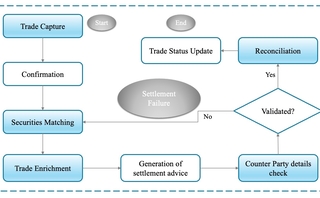Waters Wrap: ICE, Nasdaq and differing views about cloud
As exchanges continue to embrace cloud, the decisions they make today will have long-lasting implications.

Like many Americans, I became acquainted with Formula 1 racing after watching the Netflix docuseries “Drive to Survive.” While motorsports never really interested me, the egos and drama surrounding F1 make for incredibly entertaining television. And even though this season has kinda sucked because the driver and team championships have already been all but locked up by Max Verstappen and Red Bull Racing, the races, on their own, are still interesting to watch because of the strategies employed by the other nine teams and 19 drivers.
For example, sometimes, during the course of a race, a driver’s team might tell him to do the opposite of whatever the car in front of him does—e.g., if the car in front of you pits, you stay out; if they stay out, you pit. In a sport where fractions of a second make a massive difference, even if you know who is going to win the race, watching everyone else’s strategy to shave seconds off a lap is riveting. In pursuit of peak performance, people take different approaches—hard, more durable tires for a longer stint of a race; and softer, grippier tires for a shorter burst of speed.
Rarely does every team take the same strategy, and some—seeing what their rivals are doing—take a contrarian strategy, hoping it will win out if everyone else is wrong.
For the purpose of this column, I’m using F1 racing strategy as an analogy for exchanges and the technology investments they make—obvious, right? Anyway …
At the end of August, Max Bowie reported that Nasdaq had moved its second matching engine to Amazon Web Services’ cloud environment. The Bond Exchange went live on August 21, and will be followed by its GemX options market (the former ISE Gemini exchange platform), which is on track to migrate later this year. Nasdaq’s MRX options market was migrated last December. This is all part of a partnership with AWS that will see all of Nasdaq’s markets—as well as market data and back-office and clearing operations—migrated to the cloud over a 10-year period.
On the other hand, last week, Nyela Graham reported that Intercontinental Exchange’s ICE Global Network is rolling out a trans-Atlantic data service that will offer ultra-low latency data, running from the US to Europe. While the likes of Nasdaq, CME Group, LSEG, and Deutsche Börse—among others—have announced major partnerships with Big Tech giants AWS, Google, or Microsoft, ICE has chosen (to this point, anyway) not to follow the pack. While the Atlanta-based exchange is not anti-cloud—far from it—it has held off on signing exclusive contracts with the Big Tech providers (again, to this point).
At this year’s FIA Boca conference in March, Trabue Bland, senior vice-president for ICE’s futures exchanges, had this to say: “We really want to control that technology, and we actually think we do a very good job of that. I can’t even imagine the thought of outsourcing that critical infrastructure to the cloud.”
He added that ICE CEO Jeff Sprecher and CTO Mayur Kapani were confident the exchange was better placed than large tech providers to manage data-storage projects. “If you asked either one of them or any of the management team if they felt they could do something better than AWS, they’ll say, ‘Yes,’” Bland said.
Now, to be clear, I’m not saying that ICE is intentionally zigging because Nasdaq zagged, or vice versa. What is interesting are the strategies that these vital marketplaces are deploying. While “cloud” has been around for quite some time now, the capital markets are still in the very early days when it comes to cloud migration efforts, but cloud is the way of the future. And the choices that are made today by these exchanges will either set them up for success in the future, or put them behind the eight ball (or snooker them … whichever cue sport you prefer). So it is that Nasdaq is making a big Big Tech cloud play, while ICE is investing heavily in its proprietary infrastructure.
I don’t have a horse in this race—I’m all about the cheesy sports analogies today, apologies—so let me say that at this point, both strategies make sense. ICE wants to leverage its investments in infrastructure to run its markets. But for Nasdaq (and several others), which runs and operates platforms for other exchanges, the cloud makes rolling those out much quicker, easier, and more cost-effective. ICE doesn’t have that business line/cost base.
Let’s expand the conversation, though. CME’s deal with Google was also a 10-year agreement that included the tech behemoth making a $1 billion equity investment in a new series of non-voting convertible preferred stock of the exchange. Remember that the CME made major investments in its Aurora, Illinois datacenter, but then sold the datacenter to CyrusOne in 2016 for $130 million. The sale included CME entering into a 15-year lease for datacenter space and Aurora would continue to operate CME’s electronic trading platform, CME Globex, from the datacenter and would offer co-location services there.
Recently, though, Chicago-based prop-trading shops—which have made major investments to connect to the Aurora datacenter—have expressed concern about CME moving completely out of the facility and into the cloud. It should be noted that the flap started after the CME asked some members where it should locate its datacenter if it decided to leave Aurora. Said one source at a prop-trading shop, “The industry is furious. … It’s causing a lot of frustration.” But Terry Duffy, CME’s chairman and CEO, has told members that the exchange doesn’t have plans, currently, to move, though he hasn’t taken a move completely off the table.
And then there’s LSEG, which has been on quite the acquisition spree over the last few years. Like Nasdaq, the London exchange has a business line where it sells exchange technology (MilleniumIT, now Millenium Exchange) to emerging market exchanges. So like Nasdaq, selling those wares via the cloud makes sense. But also, in order to supercharge its Refinitiv acquisition (and Refinitiv’s Workspace platform), it needs Microsoft’s help (and the help of Microsoft Teams and Excel).
Now, back to ICE. If one wanted to be cynical, one could say—and one (person) has said to me—that with all the different areas that ICE serves (including its much-publicized foray into mortgage tech), Google and its analytical capabilities would make a perfect tie-up. But would ICE want to be an also-ran and play second fiddle to CME with a partnership announcement now?
I’m not in that boat, even if I lean toward being a cynic on most things. Rather, I think that ICE executives are going after a “best of breed” approach that is cloud-agnostic, while leveraging the massive investments in hardware that it’s already made. Or, maybe it envisions the ICE Global Network—which traces its roots back to its Secure Financial Transaction Infrastructure (SFTI) and 7ticks network and hosting businesses—becoming the groundwork of what becomes “ICE Cloud”?
Something else to ponder—and this is a story that Max is working on—but what about the idea of multicasting in the cloud?
Those who are making big bets on creating exclusive partnerships with a major cloud infrastructure provider are going to have to contend with concerns around latency and fairness—the latter of which has not been talked about as much as the former, but will take on greater clout in the coming years.
After reading the story we published about Nasdaq moving a second exchange to the cloud, one market data expert reached out and told me that one of the more interesting pieces of the story was a bit that had to do with AWS Outpost. From that story:
“Following our successful migration of the first US options market (MRX) to the cloud last year, we continue to build on and leverage the Outpost edge computing solution we developed with AWS to support the cloud transformation of the capital markets ecosystem,” the spokesperson adds.
The solution referred to by the spokesperson required the construction of a new data hall last year at the Equinix facility to house the AWS Outposts servers that would run Nasdaq’s new cloud presence. On its first day live on Outposts, MRX processed 4.2 billion messages and achieved a 10% improvement in roundtrip latency as a result—Nasdaq describes MRX’s resulting latency as “low double-digit microseconds,” but declines to provide specific latency figures.
AWS Outposts weren’t originally developed with the needs of exchange operators in mind. The service—which allows users to deploy racks of AWS servers in their own facilities or a co-location environment—was designed to serve use cases in various industries, including healthcare, media and entertainment, telecommunications, and other areas of financial services.
Says the source: “The AWS Outpost aspect was interesting. Bringing AWS to Equinix in such a way is arguably one way of opening their infrastructure to the financial markets. How will Google/Microsoft match this for CME/LSEG, respectively?”
Additionally, as noted previously, the CME spent a fair amount on microwave technology for latency. One could wonder if networking and latency will continue to improve, and therefore, those more “traditional” trading technologies will always be a good distance ahead of where the cloud providers will be. This means, as the data expert said to me, that those who are not in the cloud will be able to provide a strategic edge. “ICE might always have the benefit of using on-prem and cloud where needed,” the source says.
Finally, exchanges are required to provide market data at the same time to ensure fairness and transparency in the market. “Market participants need access to accurate, timely market data, and the capital markets are premised on the notion that this data is broadly accessible to all participants. So, if an exchange moves and makes its data available in cloud, then has it essentially met that criteria? If a participant chooses to connect to that exchange outside the cloud, then it’s on them and they are at risk of losing fairness as the data leaves the cloud,” the data expert says.
Dear reader, I don’t have the answers to any of these questions/thoughts. But they are the basis of conversations being had in boardrooms around the globe. When it comes to exchange tech, there’s a tectonic shift underway. I’m not sure who’s leading the race and who is making on-the-fly strategy adjustments, but make the wrong decision as a tech leader and you’re likely to end up like Mattia Binotto—out of a job.
The image accompanying this column is “Paul Lafond and Alphonse Cherfils Examining a Painting” by Edgar Degas, courtesy of the Cleveland Museum of Art’s open-access program.
Further reading
Only users who have a paid subscription or are part of a corporate subscription are able to print or copy content.
To access these options, along with all other subscription benefits, please contact info@waterstechnology.com or view our subscription options here: http://subscriptions.waterstechnology.com/subscribe
You are currently unable to print this content. Please contact info@waterstechnology.com to find out more.
You are currently unable to copy this content. Please contact info@waterstechnology.com to find out more.
Copyright Infopro Digital Limited. All rights reserved.
You may share this content using our article tools. Printing this content is for the sole use of the Authorised User (named subscriber), as outlined in our terms and conditions - https://www.infopro-insight.com/terms-conditions/insight-subscriptions/
If you would like to purchase additional rights please email info@waterstechnology.com
Copyright Infopro Digital Limited. All rights reserved.
You may share this content using our article tools. Copying this content is for the sole use of the Authorised User (named subscriber), as outlined in our terms and conditions - https://www.infopro-insight.com/terms-conditions/insight-subscriptions/
If you would like to purchase additional rights please email info@waterstechnology.com
More on Emerging Technologies
Quants look to language models to predict market impact
Oxford-Man Institute says LLM-type engine that ‘reads’ order-book messages could help improve execution
The IMD Wrap: Talkin’ ’bout my generation
As a Gen-Xer, Max tells GenAI to get off his lawn—after it's mowed it, watered it and trimmed the shrubs so he can sit back and enjoy it.
This Week: Delta Capita/SSimple, BNY Mellon, DTCC, Broadridge, and more
A summary of the latest financial technology news.
Waters Wavelength Podcast: The issue with corporate actions
Yogita Mehta from SIX joins to discuss the biggest challenges firms face when dealing with corporate actions.
JP Morgan pulls plug on deep learning model for FX algos
The bank has turned to less complex models that are easier to explain to clients.
LSEG-Microsoft products on track for 2024 release
The exchange’s to-do list includes embedding its data, analytics, and workflows in the Microsoft Teams and productivity suite.
Data catalog competition heats up as spending cools
Data catalogs represent a big step toward a shopping experience in the style of Amazon.com or iTunes for market data management and procurement. Here, we take a look at the key players in this space, old and new.
Harnessing generative AI to address security settlement challenges
A new paper from IBM researchers explores settlement challenges and looks at how generative AI can, among other things, identify the underlying cause of an issue and rectify the errors.








